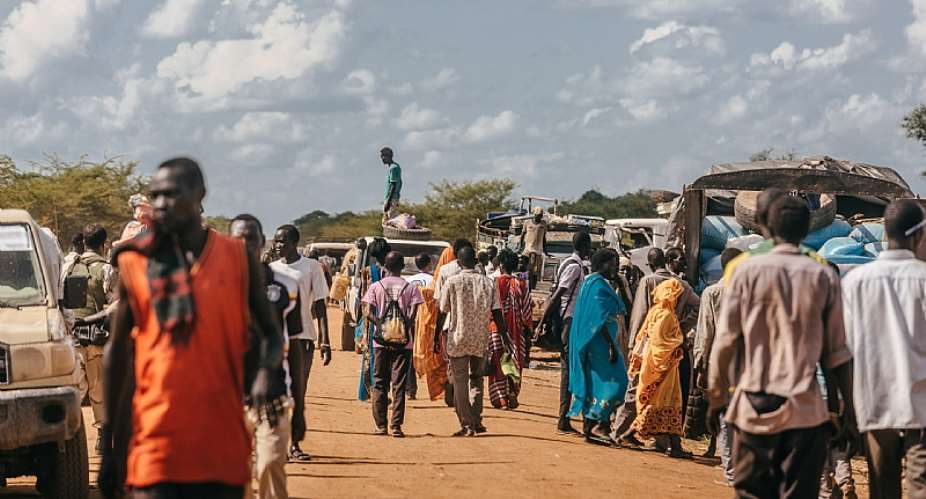Geneva/ Addis Ababa, 26 March – Conflict and violence remain the main drivers of displacement and movements in sub-Saharan Africa in 2022, exacerbated by increasing climate shocks and hazards, according to a new report launched today by the International Organization for Migration (IOM) and the African Union Commission (AUC).
The report, which is the second edition of the Africa Migration Report, highlights that migration primarily occurs within the Africa continent, rather than beyond its borders.
The interlinks between migration drivers in Africa, including economic disparities, political instability, and the impacts of climate change is also emphasized in the report. Prolonged drought in the Horn of Africa and severe seasonal flooding across the continent evidently led to record internal displacements in 2022, adding to the fact that many African countries experienced conflict and climate events at the same time.
“Conflict, violence and climate induced disasters are major drivers to displacement in Africa and around the world.,” said IOM Director General, Amy Pope. “We must adopt proactive strategic and innovative approaches to anticipate people’s movements by having early-warning systems in place and finding lasting solutions.”
Contrary to other parts of the world, new conflicts have increased displacement in sub-Saharan Africa where nine million people have been displaced in 2022 while climate shocks led to 7.4 million.
Since 2010, the number of migrant workers in Africa has increased by 53 per cent. Migrants from West, Central, Southern, and East Africa predominantly reside in neighboring African nations, highlighting the significance of return migration within Africa, particularly in countries sharing land borders.
Although migration data sources in the continent are unsystematic, the report notes that considerable progress has been achieved in recent years to enhance the availability and quality of migration and human mobility data. In the face of new complexities and crises, the report further recommends the need to build on existing data including through strengthening coordination between stakeholders at the national, regional, and continental level to inform anticipatory actions and foresight.
The report also points out the need for governments to commit to safeguarding the welfare of migrants and to coordinate migration related policies across Africa. Many of these policies fall under the auspices of the ‘Revised Migration Policy Framework for Africa’ adopted in 2018 as a framework to guide African Union Member States and regional economic communities in the management of migration.
“We convene today to launch the Africa Migration Report, 2nd Edition, a crucial joint initiative Africa Union and IOM aimed at preserving historical perspectives, portraying the right narrative on African migration while informing policy frameworks to support migration and human mobility on the Continent,” said H.E. Ambassador Minata Samate Cessouma, AUC Commissioner for Health, Humanitarian Affairs, and Social Development (HHS).
While acknowledging the potential of Africa's regional cooperation initiatives such as the African Continental Free Trade Area (AfCFTA), the report also underlines the intricate nature of human mobility on the continent, calling for a welfare-centric approach in the management of mobility.
The second edition of the African Migration Report builds on the findings of the first edition, Challenging the Narrative, released in 2020, which found that contrary to popular belief internal migration on the continent surpasses external migration.
Both reports continue to emphasize the role of well-crafted government policies in managing human mobility, particularly in light of constraints experienced during the COVID-19 pandemic.
IOM and the AUC have been collaborating on migration-related issues for over twenty years, working together to develop frameworks to help govern mobility on the continent and to assist member states to effectively manage migration.





 We saved $57.9million from procurement of new verification devices, registration...
We saved $57.9million from procurement of new verification devices, registration...
 Ejisu by-election: Aduomi is a betrayer – Ahiagbah
Ejisu by-election: Aduomi is a betrayer – Ahiagbah
 Dumsor: I’ll be in police custody if I speak, I vex — DKB
Dumsor: I’ll be in police custody if I speak, I vex — DKB
 We'll give daily evidence of Akufo-Addo's supervised thievery from our next gene...
We'll give daily evidence of Akufo-Addo's supervised thievery from our next gene...
 Asiedu Nketia crying because they've shared the positions and left him and his p...
Asiedu Nketia crying because they've shared the positions and left him and his p...
 Mahama's agenda in his next 4-year term will be 'loot and share' — Koku Anyidoho
Mahama's agenda in his next 4-year term will be 'loot and share' — Koku Anyidoho
 If you're president and you can't take care of your wife then you're not worth y...
If you're president and you can't take care of your wife then you're not worth y...
 Foreign Ministry caution Ghanaians against traveling to Northern Mali
Foreign Ministry caution Ghanaians against traveling to Northern Mali
 GHS warns public against misuse of naphthalene balls, it causes newborn jaundice
GHS warns public against misuse of naphthalene balls, it causes newborn jaundice
 Our education style contributes to unemployment - High Skies College President
Our education style contributes to unemployment - High Skies College President
